The Power of Positive Visual Narratives on Public Perceptions of Terrorism
By Millie Zhang
Editor's note: The following is an excerpt from the author's Master's thesis
Introduction
What shapes public perception of terrorism? One man’s terrorist is another man’s freedom fighter, the saying goes. Perceptions of terrorists vary depending on where one stands in the conflict. Clearly, the harms wrought by such groups can be judged differently. In fact, there is no universally accepted definition of what constitutes a terrorist. With this in mind, the general public’s views of terrorists are relatively malleable, especially due to media influence, though the word does have an overwhelming negative connotation.
Various media -- from TV to video games to established newspapers -- have narratives which, if seen from a particular perspective, can lead to the viewer to become more empathetic towards the main character that wages acts of terrorist violence in their respective communities. Can positive visual media narratives of terrorists, generate empathy towards terrorists and thus, change individuals’ real-life perceptions of terrorism?
Theoretical Argument
If a positive visual narrative framework can influence public perceptions of terrorists, the narrative of terrorists can instill an empathetic connection between the public and terrorists. With the emotional connection between the audience and the terrorists on-screen, the presence of this empathy may potentially lead to faulty intuitions made by the viewers. As stated by Jeff Victoroff, fundamental attribution error is a possible explanation for why we see young people join terrorist groups as this “cognitive bias inaccurately attributes devious and evil motives to those they perceive as oppressors.” This is one “cognitive capacity and/or style” which can possibly “affect the likelihood that an individual would sympathize with, join, follow, or lead a terrorist group.” This is why we see a heuristic form as a result of an emotional connection through empathy, even if it is a faulty one.
Recent literature asserts that viewers experience greater emotionality via visual media versus textual media. In a paper by Cho Jaeho et al., the authors find that the emotional content of television coverage of the 9/11 terrorist attacks was greater than the emotional content of newspaper coverage as well as that television news was more connected to emotional reactions to terrorist attacks than printed news. Most importantly, Cho Jaeho et al., mention the expectation that “emotional responses can function as a heuristic device in forming opinions and attitudes."
Terrorist organizations understand the benefits the media provides them and as such, will take advantage of existing platforms to publicize their activities and spread their message and cause to the world. In her research on the psychology of terrorism and its necessary relationship with the media, Michelle Ward Ghetti confirmed that a “symbiotic relationship” exists between terrorism and media. Understanding the potential impacts which the framing of terrorists have on the general public can help hamper terrorists’ recruitment rates, as well as provide deeper insight on the psychology of terrorism to better equip governments to combat terrorists.
Research Design
This study explores how the positive framing of terrorists in visual media generates empathy for the terrorists among viewers. Lab experiments were comprised of a treatment -- exposure to three episodes of Japanese animated TV series titled “Terror in Resonance” and study of the viewers responses. The units of analysis are the participants -- current CMU students who are 18 years and older, resulting in more accurate results, using a more focused demographic. However, this limitation mean the findings are not representative of the American population as a whole.
“Terror in Resonance” takes place in an alternate reality of Tokyo which “has been decimated by a terrorist attack” planned and implemented by “two mysterious children” who “form a clandestine entity called ‘Sphinx’” in an attempt to shine light on the human rights atrocities of the Japanese government towards orphans. This particular show humanizes terrorists and makes a point of depicting the characters’ journey as one similar to the plight of the down-trodden.
The focus of this lab experiment is to determine the effects of positive visual narratives of terrorist characters on perceptions of terrorism as a whole. Using “Terror in Resonance” as my treatment, “Love Hard” -- an American romantic comedy devoid of any reference to terrorism – was selected to serve as the control.
Results
Broken into three different graphs representing three categories of terrorist groups - eco-terrorism, religious terrorism, and ethnic terrorism -- the bar graphs – figures 1, 2, and 3 -- indicate that there is a treatment effect.
The Y-axis represents participants’ average approval based on the Likert scale with 1 being “Extremely disagree”, 2 being “Slightly disagree”, 3 being “Neutral”, 4 being “Slightly agree”, and 5 being “Extremely agree.” This means that if the treatment has a larger Y-axis than the control according to the bar graph, the treatment group had higher levels of average approval compared to the control group.
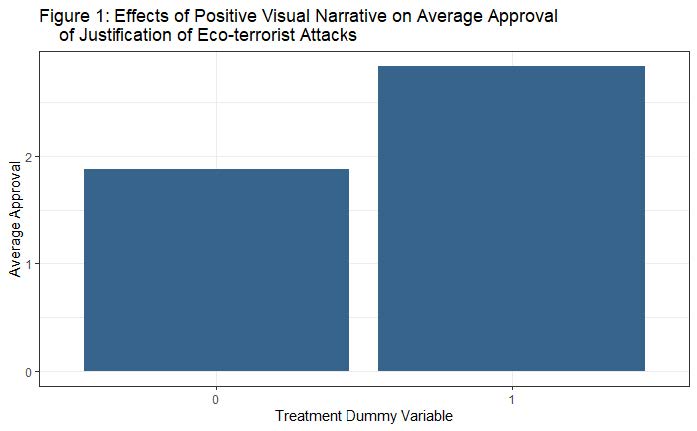
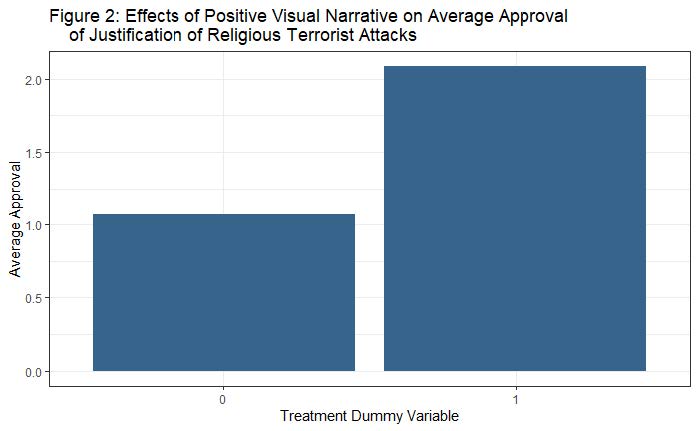
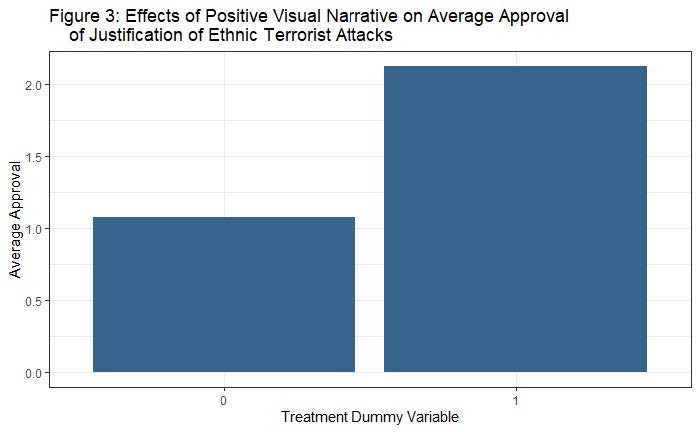
However, in order to determine that this visual treatment effect is statistically significant, linear regression models were run in three regression outputs. According to the results of the regression outputs, there was a statistically significant treatment effect in the average approval of whether or not terrorist attacks are justified for eco-terrorism, religious terrorism, and ethnic terrorism. Despite the fact that the research demonstrated statistically significant treatment effects, this was not prevalent throughout all of the study; there was a key difference. More specifically, the experiment results show that positive visual narratives could shape public approval of particular types of terrorist attacks but not their policy preferences.
This was the case with the results of participants’ answers to the post-test questions regarding their feelings on government negotiations with eco-terrorists, religious terrorists, or ethnic terrorists. In contrast with the results of average approval of the justification of terrorist attacks, the bar graphs demonstrated little to no treatment effect.
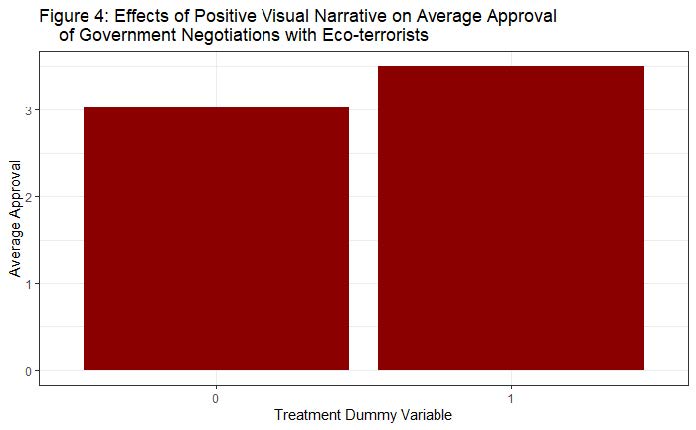
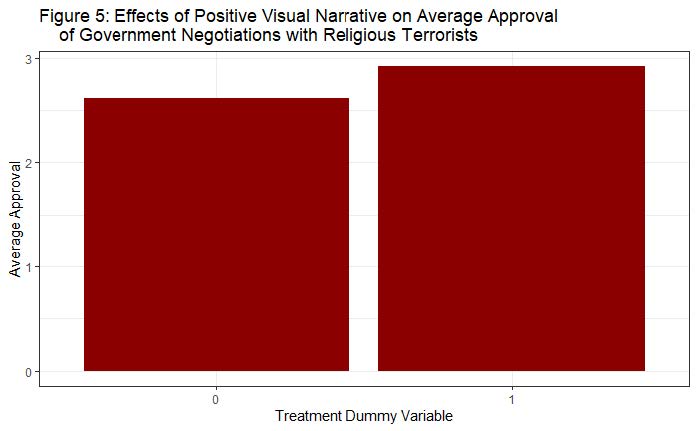
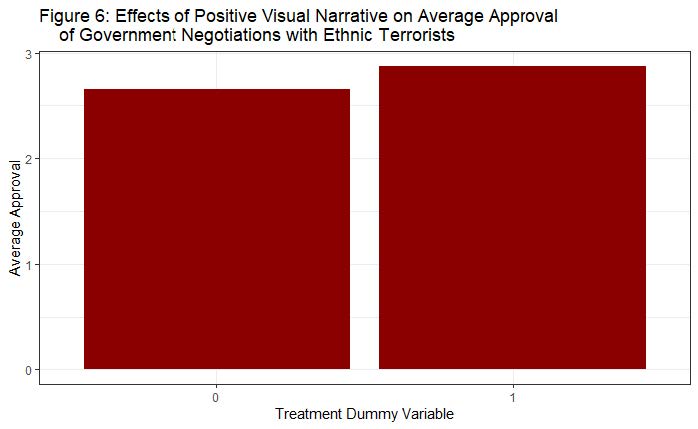
Once again, linear regression models were run to determine whether or not there was statistical significance. The p-values were all greater than 0.05, demonstrating that there were no statistically significant treatment effects.
As mentioned previously, in order to run covariate balance checks, bar graphs were generated with key demographics as dependent variables. The treatment dummy variable was the independent variable.
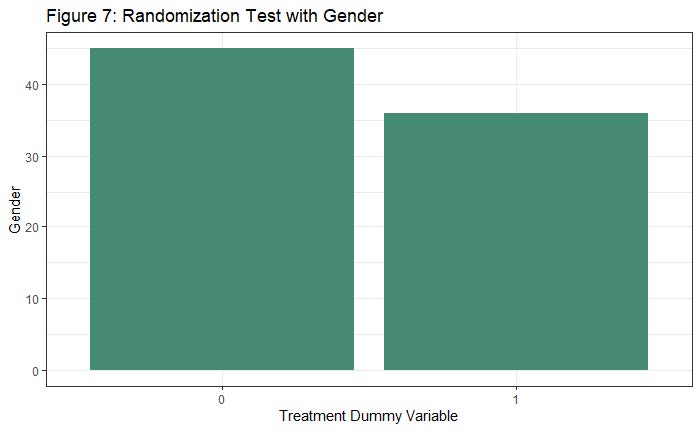
The first demographic tested was gender. Taking a look at the bar graph in Figure 7, there appeared to be a potential negative treatment effect. However, after testing with a linear regression model, it is clear that there is no statistically significant relationship between participants’ gender and the treatment dummy.
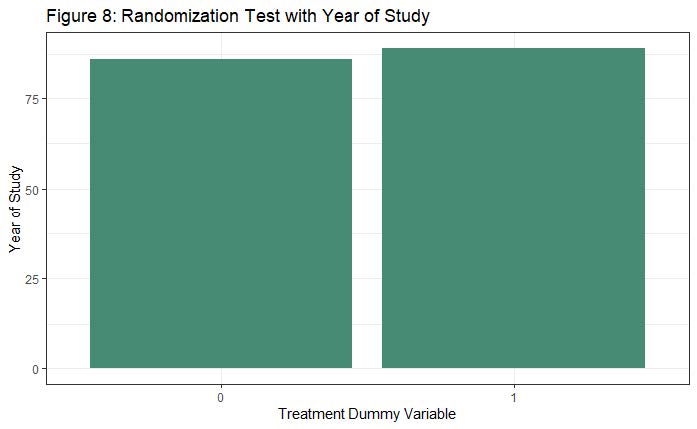
Participants’ year of study was the second demographic tested. Unlike Figure 7, there is almost no visual difference whatsoever with the bar graph for year of study and the treatment dummy variable in Figure 8. As none of the variables tested for randomization, demonstrated any statistically significant relationship with the treatment, we can confidently assert that the randomization truly worked as there was no covariate imbalance.
Discussion
What shapes public perception of terrorism? The findings of this study indicate the following two conclusions:
- There is a positive significant treatment effect in participants’ feelings towards the justification of terrorist attacks.
- There is no significant treatment effect in participants’ feelings towards government negotiations with terrorist groups.
Understanding how positive visual narratives can shape public perceptions of terrorism will better equip the U.S. government in combatting terrorism. Whether that be through keeping news media accountable regarding the way in which they frame terrorist groups and terrorist attacks, or through how best to inhibit terrorists’ recruitment practices and strategies, all the stakeholders critical to understanding and countering terrorism will find more research in this area beneficial to their efforts of bringing about peace and security.
